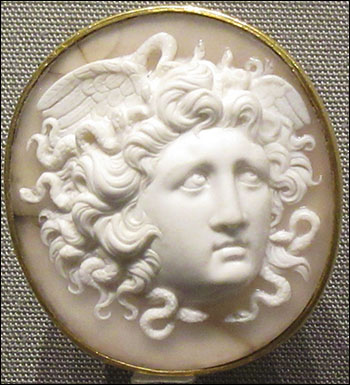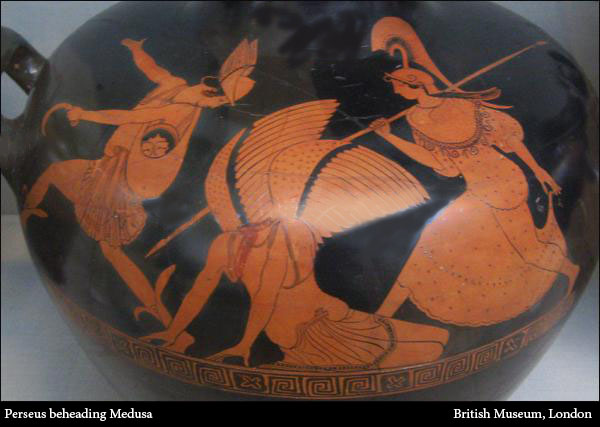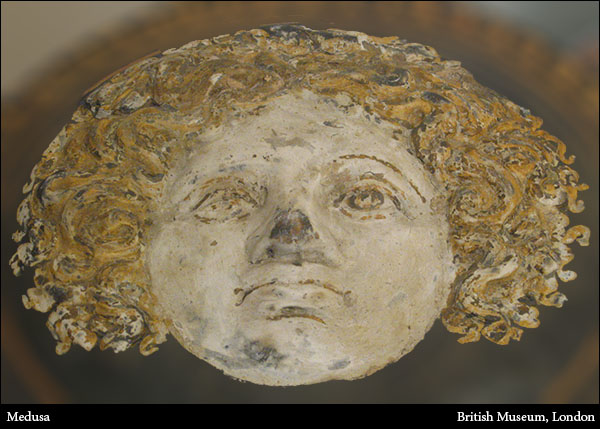
| The Three Gorgons |
| The Murder of Medusa |
| Bibliography |
| Previous Page |
| Homepage |
| Site Search |
Medusa and her sisters, Sthenno and Euryale, were the daughters of the ancient, pre-Titan Immortals, Phorkys and Keto. All three sisters were so hideous that the shock of seeing them would turn anyone to stone. All three sisters had snakes writhing on their heads, around their waists and around their wrists. Medusa, Sthenno, and Euryale are generally called the Gorgons but Medusa had the honor of being called The Gorgon, or in the singular, Gorgo.
Sthenno and Euryale are immortal but Medusa was mortal and ruthlessly killed by the son of Zeus, Perseus. As to how Medusa could be the only mortal daughter born to immortal beings is hard to comprehend but we must simply take it as a fact. Other children of Phorkys and Keto, and therefore sisters of the Gorgons, are the Hesperides and the Graiae. All of the children of Phorkys and Keto live in the mysterious West, beyond Okeanos (Ocean) in the utmost place towards the abode of Nix (Night).
Olympian Zeus, father of gods and men, honored Medusa even after her brutal slaying by his son Perseus. The aegis (shield) of Zeus displayed the head of Medusa as the centerpiece surrounded by images of Phobos (Panic) and Eris (Discord). On the aegis, Medusa's head was topped with snakes and her tongue lolled from her gaping mouth. The Gorgon head was meant to be a portent of the awful and ruthless power of Zeus.

The sad fate of Medusa was linked to the infatuation of Zeus with Princess Danae, the daughter of King Akrisios of Argos. The king was told by an oracle that Danae would have a son who would kill him and take his throne. To thwart the oracle, Akrisios had Danae locked in a bronze vault so she could not be seduced or wed ... Zeus came to Danae inside the vault as a shower of gold ... Danae's son Perseus was a result of Zeus's presence.
Akrisios placed Danae and her new-born son in a coffin-like box and cast them into the sea. The box washed ashore on the island of Seriphos and was found by a man named Diktys, who happened to be the brother of the island's reigning monarch, King Polydektes.
Danae and Perseus made their home on Seriphos and King Polydektes fell in love with Danae, but she did not return his affection. As Perseus grew older, he became an imposing young man and King Polydektes thought that if he could get rid of Perseus, he would be able to seduce Danae.
Polydektes devised a plan to send Perseus on what he thought would be a suicidal mission ... he convinced Perseus to bring him the head of Medusa. To assure his success and thwart Polydektes's machinations, Perseus needed the protection of Zeus's daughter Athene and his son Hermes.
Perseus first sought out the sisters of the Gorgons, the Graiai (the Gray Sisters), who were three women, gray from birth, who shared one tooth and one eye between them. Perseus stole their tooth and eye and, using them as ransom, forced the Graiai to give him the location of the Nymphs who had possession of the Cap of Hades (which would make him invisible), a pair of winged sandals (for flying) and a kibisis (a bag to hold Medusa's head). Perseus later obtained a sickle (or sword) from Hermes and set out to slay Medusa.
With the help of Athene, Perseus found the Gorgons asleep and was able to cut off Medusa's head before they detected his presence. After the attack on their sister, Sthenno and Euryale chased Perseus, but his flying sandals saved him. As Perseus flew over the Libyan desert, the drops of blood from Medusa's severed head produced a brood of vile serpents, the winged horse Pegasos and the monster with the golden sword, Khrysaor.
Flying over Aethiopia on his way to Seriphos, Perseus encountered the beautiful Andromeda, the doomed daughter of Kassiopeia and Kepheus. Kassiopeia had boasted that she was as beautiful as the Nereids and to avenge the insult Poseidon, lord of the sea, sent floods and one of his monsters to ravage Kepheus's kingdom.
The only way to call off the wrath of Poseidon was to sacrifice Andromeda to the monster. Using the head of Medusa, or perhaps only his sword, Perseus was able to destroy Poseidon's monster and save Andromeda. King Kepheus's brother Phineus refused to let Perseus claim Andromeda for his wife so Perseus showed Phineus the head of Medusa for his defiance and turned him to stone.
The situation on Seriphos had worsened during Perseus's absence. King Polydektes had become obsessive and violent in his treatment of Danae. Perseus found his mother and the king's brother Diktys hiding at the altars. Perseus confronted Polydektes and his comrades in the palace. With eyes averted, Perseus showed Polydektes the head of Medusa. All those present were turned to stone in whatever pose they were in when Perseus revealed Medusa's severed head.
Diktys married Danae and became king of Seriphos. With his mother's safety and happiness assured, Perseus gave Medusa's head to Athene to place on Zeus's shield.
Perseus's grandfather Akrisios had set the dramatic events of Perseus's life into motion by his fear that his grandson would someday kill him. As fate would have it, Akrisios had left Argos by the time Perseus returned from his adventures but he could not escape the grand design of the Immortals. While Perseus was participating in an athletic competition, he accidentally threw a discus into the spectators and killed Akrisios. Perseus refused the throne of Argos and went to Asia Minor where his son Perses founded the race that would become known as the Persians.

The Iliad
The Odyssey
Theogony
Catalogue of Women
Shield of Herakles
Kypria
The Histories by Herodotos
The Odes of Pindar
Description of Greece by Pausanias
Library of History by Diodorus of Sicily
The Argonautika by Apollonius of Rhodes
The Library by Apollodorus of Athens